
by Nancy Jaffer | May 29, 2025
It was a morning of peaks and valleys at the Devon Horse Show on Thursday for Colin Syquia and Jennifer Hannan, as the couple shared a wide range of emotions.
There were smiles for Colin’s victory with Front Page in the show’s $50,000 USHJA International Hunter Derby, and tears as Jennifer’s beloved mount, Mindful, was given a farewell ceremony in the same arena.
But as she wiped her eyes, Jennifer noted the way it happened was “actually a double high, so great for Colin to win today” and “for Mindful to retire that way.”
Front Page, a Belgian warmblood, moved up from seventh place in the classic first round, earning a mark of 101from one of the two sets of judges, followed up by a 100 in the second round, the handy. The derby was a major goal for Colin, as Front Page is shown primarily in the amateur division by his owner, Cynthia Sulzberger. She’s a member of the family that publishes the New York Times; hence, her horse’s appropriate name.

Colin Syquia and Front Page. (Photo © 2025 by Nancy Jaffer)
Front Page, who was champion in the second-year green hunters at Devon two years ago, “loves this venue. like I do. It’s iconic. You feel the energy. It makes you want to perform better. It’s a special place,” said Colin.
Referring to the historic trophies on display at the showgrounds, he noted, “If you’re lucky enough to have your name and your horse’s name engraved on that trophy, it’s immortalized.”
He said he and Front Page “have gained a great relationship.” He didn’t focus on every single class in the run-up to the derby, instead opting to get him stronger and looser. “So in the end, he’s fresh and happy.”
The horse knows when a competition is special.
You might not even notice him at an ordinary show, Colin said but “When he comes here, Kentucky or the National, he just grows a hand, he’s alert, his jump is electric.”
The next goal Colin has with the horse is the finals of the Platinum Performance/USHJA International Hunter Derby Championship in Kentucky this summer. There he will meet up again with Hunt Tosh, a three-time winner in Kentucky, who settled for second at Devon with the Wheeler family’s Cannon Creek, and Michael Britt-Leon, third Thursday with Mark Dorfman’s well-behaved stallion, Prime Time. Like Cannon Creek, he is a Holsteiner.
The leader after the first round, which drew 31 starters, was Four Aces, ridden by David Wilbur. But the momentum didn’t last and that combination wound up ninth after the top 12 came back for the handy round.
“It was a great course today I thought, both rounds,” said Hunt, noting he had a rub in the first round.
“It was a great atmosphere we all have a good time in the schooling area and watching each other go. Every great hunter, I believe, has a story behind it at Devon.”
People who have horses at the level of the top performers in the Derby “start planning their careers and their show schedules around Devon,” Hunt mentioned.
Michael felt like “a little bit of an underdog coming out” because the horse is new for him since last fall, when he rode him at the indoor shows. But he said Prime Time is “very, very mellow…you know he’s going to get to the other side of all the jumps.”
Since this was their first derby together, he had “low expectations and just wanted to have a nice smooth round today.”
He said the course designed by Alan Lohman offered many possibilities.
“The jumps were large and there were definitely a lot of questions on the course that you could kind of make your own and keep it exciting,” said Michael, admitting to being “a bit of a ham,” adding he felt Hunt and Colin had the same inclination.
Mindful, a 21-year-old Hanoverian who could be 10 if you judged by his well-kept looks, was surrounded by friends as his saddle was removed for the last time and replaced with a blanket of white roses.
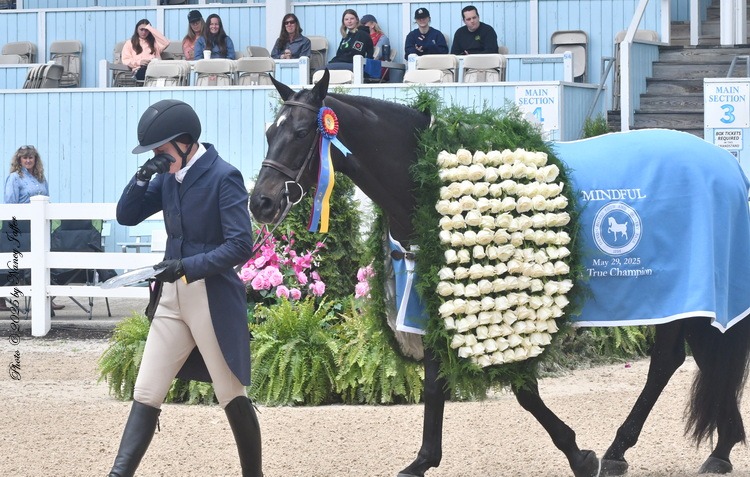
Jennifer Hannan wipes away her tears as she leads Mindful out of the arena after his retirement ceremony. (Photo © 2025 by Nancy Jaffer)
His owner, Selma Garber, and former rider, Kelley Farmer, were on hand to wish him farewell for his retirement in Rhode Island. He will be turned out with his buddy, Olympic Fire, another hunter, and get plenty of his favorite treat, Publix iced oatmeal cookies.

Mindful’s former rider, Kelley Farmer, and his owner, Selma Garber, were on hand at his retirement. (Photo © 2025 by Nancy Jaffer)
He was imported from Europe as a jumper, and ridden by Canadian Jay Duke. He switched to the hunters and was an immediate success. Jennifer started riding him 10 years ago.
“He’s really sound and he’s great, but he’s 21 years old,” said Jennifer, explaining the decision to retire him.
Then she added quickly, “He’s still spry and very happy.”
At age 20, Mindful won a hunter derby at the Winter Equestrian Festival in Wellington, Fla. But at the beginning of their relationship, it took some time for Jennifer to connect with him.
The first year, she got bucked off regularly, and then realized “I was going to learn from him. We ought to look inside our horses and figure out what makes everything tick.”
Jennifer added she is, “Grateful for an incredible experience with him. He has changed my whole career.”

by Nancy Jaffer | May 29, 2025
As I was on the rail taking photos of the jumpers at the Devon Horse Show, I heard an older woman in the seats behind me telling her friend as a certain star rider entered the arena, “That’s McLain Ward. I saw him on TV at the Olympics, and now he’s at Devon!”
McLain has fans in many places, but nowhere more so than Devon, where he gets the loudest cheers when he enters the ring and also when he leaves, win or lose.
Wednesday night, it was a win, as he and a newer horse, the Holsteiner La Serra “a very nice, careful mare,” finished ahead of 34 other starters in the two-phase $38,700 Main Line Challenge Stake, which we used to call a power and speed. The fences were set at 1.45 meters (as opposed to up to 1.5 meters for Thursday’s 4-star Grand Prix) and both segments were timed. La Serra was fault-free in 31.32/31.05 seconds.
The complicating factor was the drenching rain and cold, very uncharacteristic for late May in the Philadelphia suburb. McLain was totally soaked, and still dripping after he dismounted. You can see the downpour in the lead photo on this website.
I asked about the weather as a factor affecting the competition and Mclain said, with a smile,”It’s part of the game. Cold and wet, but we have to make a living. So…”
For awhile, he was first and second. Snapchat van de Broekkant Z, a 9-year-old Zangersheide finished just behind his stablemate (0/0, 30.78/32.76). But Kaitlin Campbell had something to say about it and ended as the runner-up on the Oldenburg gelding Bull Run’s Hesed (0/0,32.20/31/76).
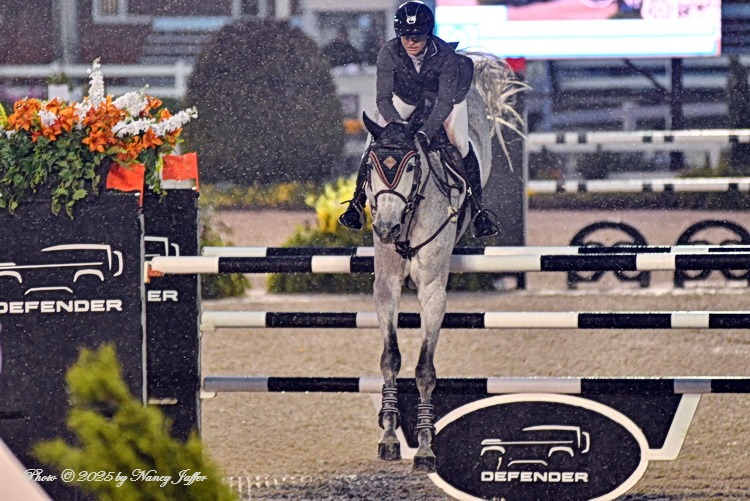
Kaitlin Campbell and Bull Run’s Hesed. (Photo © 2025 by Nancy Jaffer)
Jessica Springsteen, appearing at Devon for the first time in 10 years, was third with the Swedish warmblood mare Galaxy Girl (0/0,31.88/31.91).
McLain is in the process of building his string of horses. His longtime partner, Contagious, will be retired, he revealed, but he has a new star in Imperial HBF, who put in the crucial clean anchor round last weekend at the Rome Nations Cup to insure victory for the U.S.
Even though he will be on the team in La Baule, France, next week, McLain flew home to be part of Devon.
“These are important events and I enjoy them. It’s good for developing horses to get the experience as well,” he explained.
The grand prix is named in memory of Sapphire, the mare who won it twice with McLain in the saddle. She also retired at Devon, which strengthened her connection with the show.
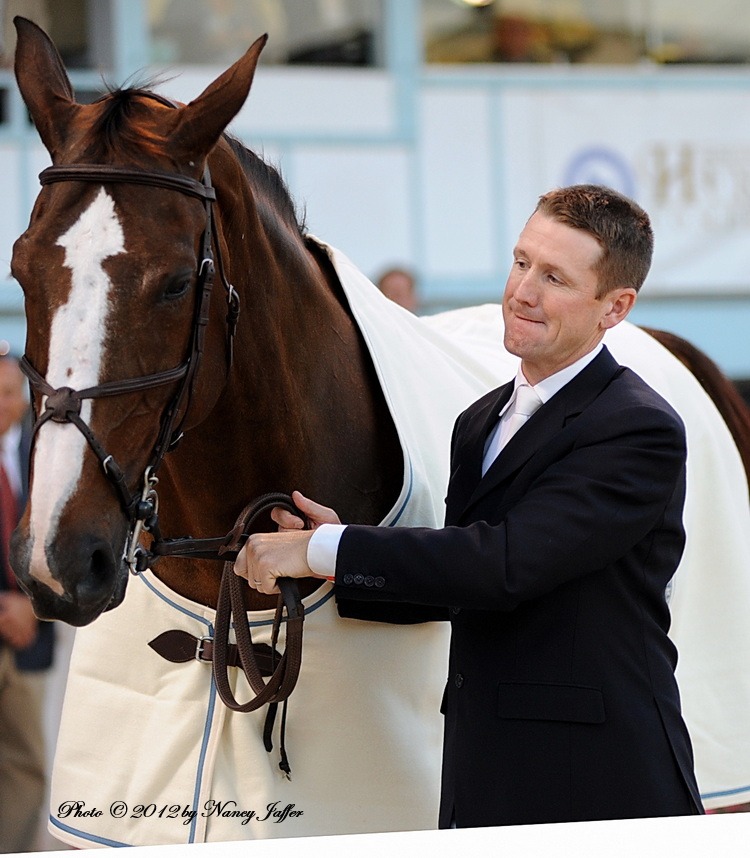
McLain Ward and Sapphire at her retirement during Devon, 2012. Photo © 2012 by Nancy Jaffer
His 10 employees are divided between Europe and the U.S., so he has excellent strings of horses both here and abroad.
Kaitlin is used to winning at Devon, where she was an achiever in the junior jumpers. She has been riding Bull Run’s Hesed since last fall and called him “a very fast horse, very elastic. It took a little bit of time for him to get to know me and me to get to know him, but it’s really come together in the last couple of months.”
Based in California where she finds the shows at Thermal a good place to “put all the pieces together” and bring horses along, she is originally from Doylestown, Pa., and rode with Patty Miller.
Thinking back to her pony days at Devon, she said riding in the show “definitely feels like coming home.”
A new owner, Mirasol Equestrian, has invested in horses for her, so she’s putting a string together with horses available for every type of class. She did the World Cup finals in April, her first senior championship.
“It was definitely eye-opening, the level of competition and the size of the fences,” she commented.
Kaitlin is hoping to qualify for the FEI World Cup Finals in Fort Worth, Texas, next year.
Jessie never had competed in the open jumper division at Devon, and always wanted to do it. She has had her horses stabled at her family farm in Colts Neck, N.J., a short commute from Devon. Her parents, Bruce Springsteen and Patti Scialfa, have their own horses at the farm, and like to ride western on the trail.

Jessica Springsteen and Galaxy Girl. (Photo © 2025 by Nancy Jaffer)
Devon has special meaning for Jessie.
“I’m so glad to be back,” she said, noting she has had flashbacks to when she competed in the ponies at the show.
“It was so much fun.”
In the grand prix, Jessie will be riding her 2021 Olympic team silver medal mount, Don Juan van de Donkhoeve, who was out for a while with an injury. She has been building him back up so he can compete in shows at the level of Devon.
Click here for results
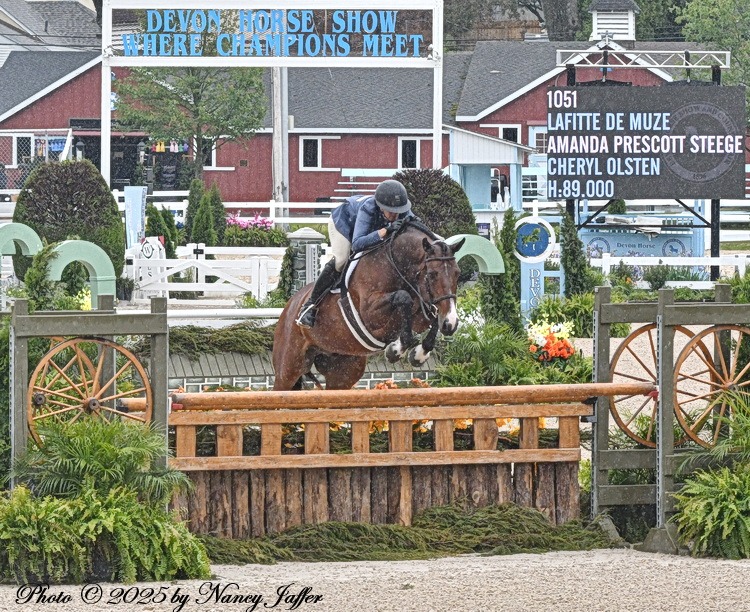
by Nancy Jaffer | May 28, 2025
They are the Devon Horse Show’s ultra hunter champions: Nick Haness, Leading Hunter Rider for the third year in a row; Scott Stewart, who piloted the show’s Grand Hunter Champion for the umpteenth time and Amanda Steege, High performance Hunter Leading Lady Rider (for the third time in four years).
They share an appreciation of their horses’ intelligence and desire to be in the game. You can see the though process of one racehorse trying to outrun another, but do show hunters understand the more subtle nuance of victory in their arena? Amanda thinks so; Scott and Nick agree.
Amanda believes that Cheryl Olsten’s Lafitte de Muze, the Belgian warmblood by Darco that she has ridden for eight years, “just really has a desire to win. I’ve never had a horse that I feel is trying to win every class as much as he is. I think that’s the thing that makes him extra special. He’s really intelligent and I think he knows when he goes in there that he’s performing.”
Lafitte was the show’s High Performance Hunter Champion, scoring a career best of 96 in the division’s final class, the stake.
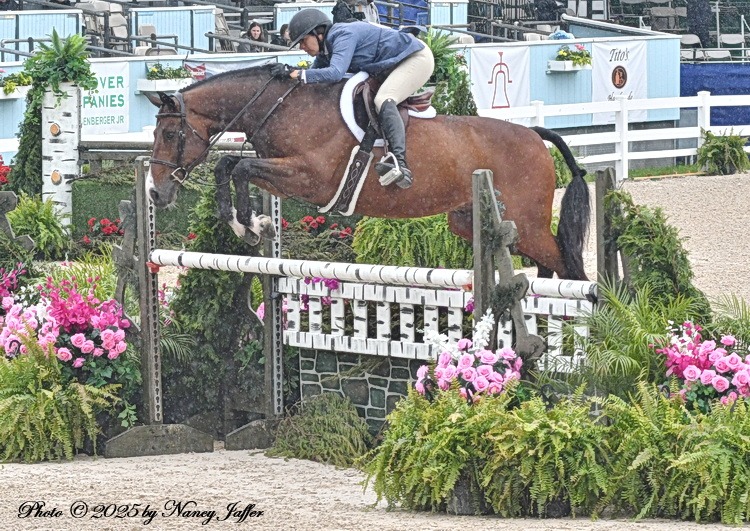
Amanda Steege and Lafitte de Muze. (Photo © 2025 by Nancy Jaffer)
Devon was the only show where he hadn’t taken that championship, said Amanda, speaking of the “elusive white cooler.”
Nick, who was aboard the Ingram Family’s Odette, the show’s Leading Mare and Green Conformation Champion, is “amazing, probably one of the smartest horses I’ve ever ridden. She’s incredibly in tune with the rider. I don’t think I’ve ever asked her to do something that she didn’t do for me,” he said of the Oldenburg, who won all the jumping classes in her division. If you have a great mare, she can do anything.
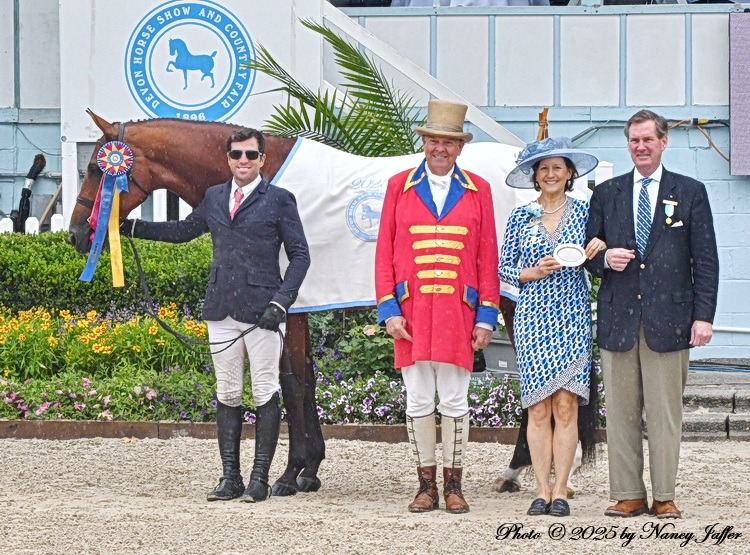
Leading Hunter Rider Nick Haness with Odette. (Photo © 2025 by Nancy Jaffer)
“I’m so excited and blessed to be riding her again this year, especially at venue like Devon,” said Nick, who was primarily in California over the winter, while Odette was in the East, ridden by Emily Williams and trained by Tom Wright.
Betsee Parker’s Grand Hunter Champion, California Love, is described by Scott as “beautiful, scopey, athletic.” The horse he bought as a three-year-old “is very laid back. When it’s a little more (atmospheric) environment, he picks up in a good way.”
Although Scott has been a winner repeatedly over the decades at Devon, the thrill remains.
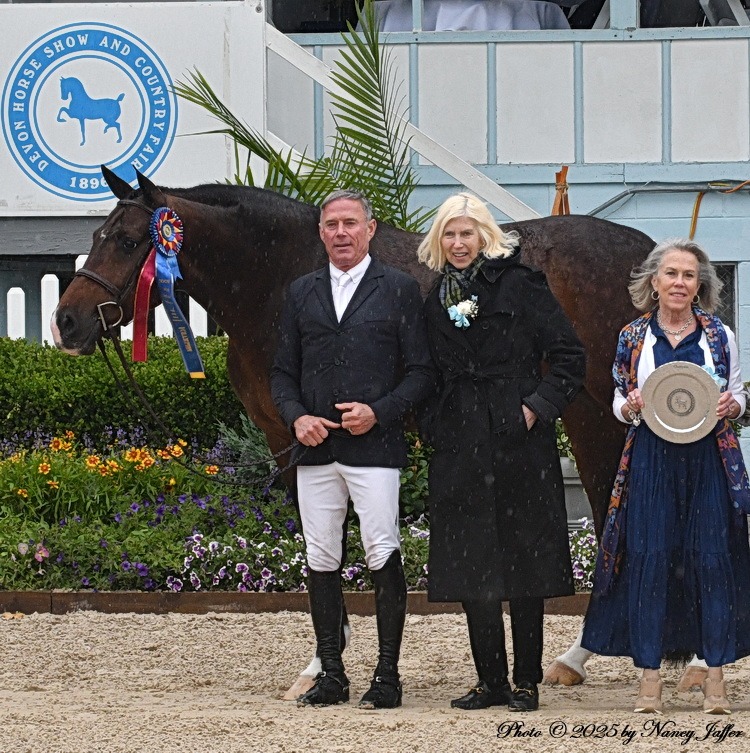
Scott Stewart and California Love with owner Betsee Parker. (Photo © 2025 by Nancy Jaffer)
“It’s still very special. The ring has great memories for me,” he observed.
Amanda’s connection with Devon started long before her personal involvement.
“This show is important to my family,” she explained.
“I have a picture of my great grandfather showing here in 1913 on his pony. My mom’s family, the Smiths, they’re from Blue Bell and Fort Washington (Pa.).
“My mom showed here when she was growing up. It was the same course every year. She jumped the first jump, then her pony he stopped at the second jump.” She would fall off and “had to walk the whole way back to the ingate.” Amanda did add that her mother persevered and finally made it around the course.
Click here to go to the results website, then click on Tuesday, May 27 and Wednesday, May 28, to see hunter champions
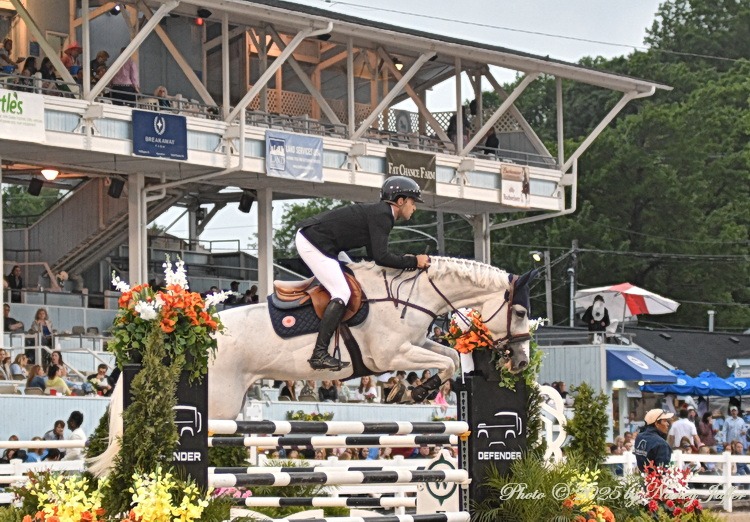
by Nancy Jaffer | May 28, 2025
The Bluman cousins made a real statement in the Devon Horse Show’s opening show jumping competition, sweeping the top placings for the Jet Run Devon Welcome Stake.
Daniel took the one-round class on his longtime partner Gemma W., while Mark finished as runner up with Ubiluc, less than a second behind the winner’s clocking of 56.21 seconds over the Anderson Lima-designed course.
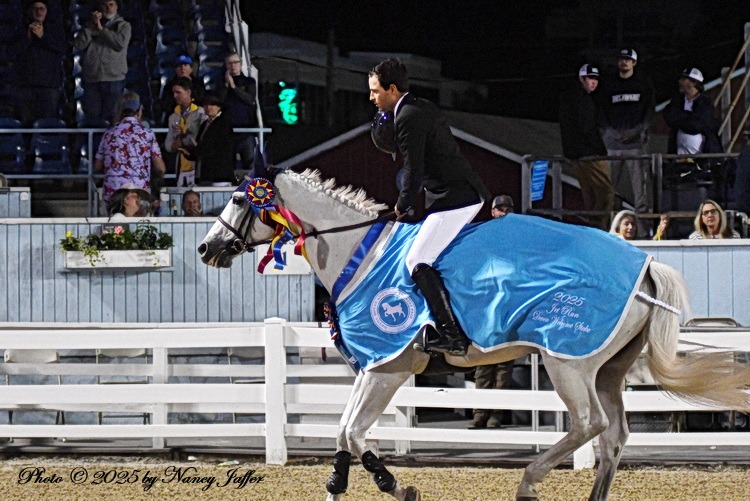
Daniel Bluman enjoys his victory lap on Gemma W. (Photo © 2025 by Nancy Jaffer)
Another Bluman, Ilan, was further down in the 43-horse field, winding up thirty-seventh and thirty-eighth with his two mounts.
There is naturally a bit of rivalry among the cousins, who grew up like brothers in Colombia, but they’re all part of the same business, so a winning finish by one is a winning finish by all.
“It’s probably the first time we’ve been 1-2 in a class. It’s always nice to have a family win, it feels great,” said Mark.
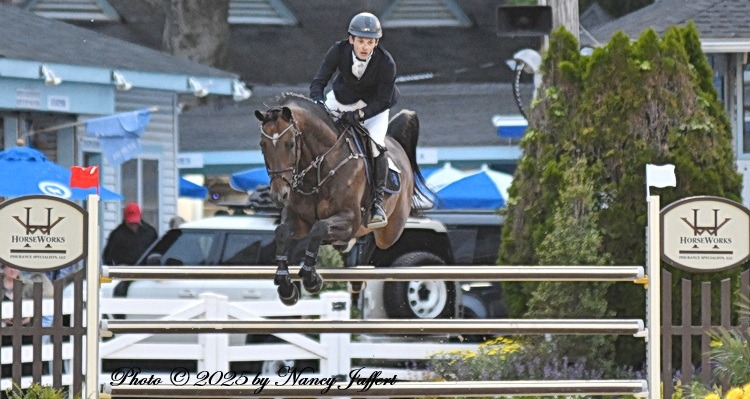
Mark Bluman and Ubiluc. (Photo © 2025 by Nancy Jaffer)
“We really love this show, we try to come every year,” noted Daniel. “We all want to be competitive, so we’re just having fun, doing what we love.”
Daniel became an Israeli citizen nine years ago. His cousins are still Colombian, but are working on switching their citizenship.
More than a dozen of the riders entered the class on two horses, with a goal of being competitive on one mount and giving the other a look at the arena and the spectators, who are always numerous and appreciative.
Daniel took it easy with Hummer Z, his mount for Thursday’s featured Sapphire Grand Prix, but he went for it with Gemma, who will have a few days off until Saturday night’s closing jumper class.
“We’ve been together for many years we know each other great,” he said of the reliable grey mare, “so for me to go at that speed doesn’t take much of an effort. She’s a fantastic horse, she’s won so much. I thought I could win the class without her making a huge effort.
“It’s always fun to beat Markie,” Daniel added slyly.
“He’s a fantastic rider. We’re all competitive. Actually, his plan was not to go fast. I think when he saw I had been fast, he got a little extra competitive and went for it. He was just not enough today.”
Family comes first, before who gets the ribbons.

Seven-year-old Tiris Carlin was thrilled to get Daniel Bluman’s ribbon from the Jet Run class. (Photo © 2025 by Nancy Jaffer)
“There’s always a rivalry, but a healthy one,” Daniel explained.
“We all work together. We run the business together, we live pretty much together, so it’s a very healthy rivalry. But of course we want to win.”
Even so, “if it had been the other way around — I’m second, he’s first — I’m just as happy. I beat him, maybe tomorrow he beats me.”
Daniel makes Devon a regular stop on his circuit.
“I think the atmosphere is lovely, the people are very nice, the crowd knows it’s like a tradition to come and be part of the horse show. It’s our responsibility as riders and professionals to support and come to these events. It’s what really keeps the sport alive. I love being part of it.”
The class is named in memory of Michael Matz’s famous horse, Jet Run, many times a winner at Devon. Michael’s son, Alex, rode Ikigai in the class, finishing thirteenth, just out of the ribbons.
click here for results
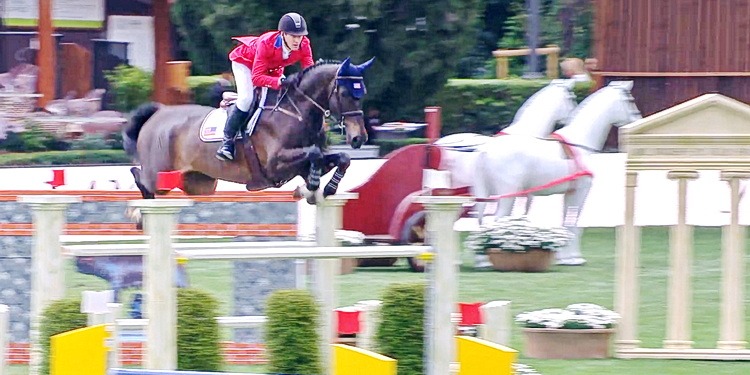
by Nancy Jaffer | May 23, 2025
A perfect round under pressure–which is the trademark of anchor rider McLain Ward–avoided a jump-off and clinched the first U.S. victory since 2009 in the Rome Nations Cup on Friday.
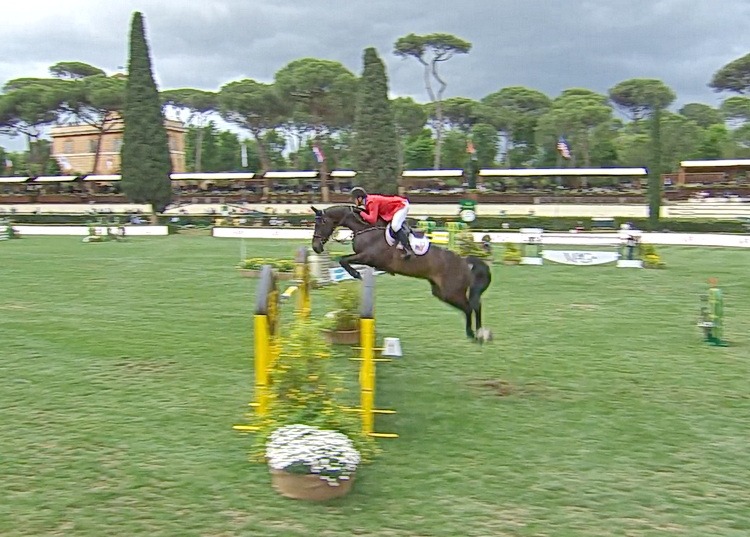
McLain Ward and Imperial in the midst of one of the world’s most beautiful venues.
Aboard his newest mount, Imperial HBF, McLain’s performance in the 5-star Nations Cup Intesa San Paolo assured America its 4 penalty score could hold off the French team, which had to settle for second on 8 penalties.
After the first round over the course designed by Uliano Vezzani on the grass field of the scenic Piazza di Siena, the U.S. was tied on 4 faults with France and Germany. But the second time around, the latter dropped to fourth behind the home team, Italy, which claimed third place on the podium with 20 penalties.
McLain, who took over the ride on Imperial in February from Great Britain’s Tim Gredley, was double clear, as was his teammate and protege Lillie Keenan aboard Kick On. Laura Kraut, who was on the 2009 team with Cedric, dropped a rail on each trip with Bisquetta. Karl Cook had a rail in the first round with his Olympic team silver medal mount, Caracole de la Roque, but was fault-free on his second go to help secure the USA’s sixth victory in the history of the class.
After lifting the silver trophy above his head, U.S. Coach Robert Ridland noted his riders have been on a real winning streak.
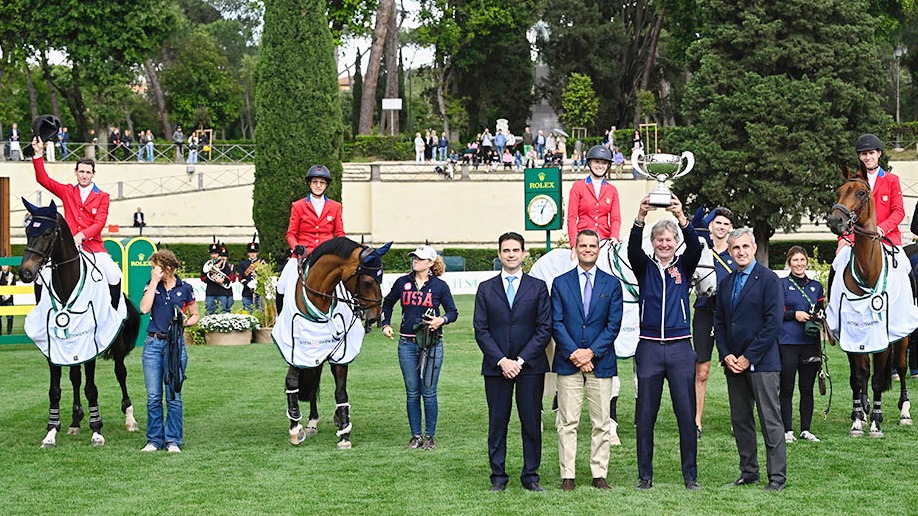
U.S. Coach Robert Ridland and the trophy, with team members McLain Ward, Laura Kraut, Lillie Keenan and Karl Cook.
“Three in a row sounds pretty good,” he said with a grin, referring to team victories this spring at the Longines FEI League of Nations in Ocala and the Nations Cup in Wellington, Fla.
He also pointed out that not only McLain, but also Laura and Lillie were on horses they had never ridden previously in a Nations Cup. Karl was the lone rider who had Cup experience with the mare he rode Friday.
The Cup “was a tough slog from the very beginning,” Robert continued.
“We drew first in the order and we were hoping that would stay true in the end, but it certainly wasn’t easy. After the first round, we knew what we had to do in the second round, and as that was unfolding, we weren’t really creating much of a gap. So we were prepared for a jump-off, but one way or another we were going to try to win this thing!”
Mclain, a member of the winning team in 1997, noted that Vezzani’s style of course designing “always allows us to ride, it’s not about tricks and it’s not hiding jumps. But you had some bold fences, the wall (centered with a statue of a wolf nursing Rome’s founders, Romulus and Remus), the triple out of the corner with the chariot in the way. And then the last line was shifting away from the side, very delicate and that’s always a challenge. This is Rome, an iconic event, and it should be difficult,” he added.
Not only had he not jumped a Nations Cup previously with Imperial, this was his first 1.60 meter class with him.
“Tim Gredley did an incredible job bringing this horse to the highest levels of the sport”, he pointed out.
And he was delighted that his pupil, Lillie Keenan, was the other double-clear. He was surprised, however, when she told the story of how Kick On received his barn name of Ken.
“I got him around my twentieth birthday, when the Barbie movie was coming out and it just seemed right,” she explained. (For those who don’t know, Barbie’s boyfriend was Ken.)
She went on to say how well he is evolving.
“He’s really gone from strength to strength, I took him to the World Cup Finals not long ago and that was at that stage the biggest thing he’d ever seen, and really going into today, he rose to the occasion and I’m so proud of him!”, she said.
Karl Cook, who won the Rolex Grand Prix of Rome with Cara in 2024, said, “Between last year and this year, it’s completely different. When I was here last year, I more or less had no expectations. I remember in the jump-off last year, I just decided whatever was about to happen was just going to happen. That kicked off my whole summer. Without this show last year, the rest of the summer would not have happened,” said Karl, for whom Rome was a precursor to his Olympic experience.
Laura noted that Bisquetta “took a little look at the wall (fence 3) which surprised me, normally she’s super-brave, so I rode her very strong and that made her very strong, so I think that first fence in the middle of the combination (fence 4) came from that. She finished very well and I thought the second round she jumped beautifully. Maybe I was a little free to the plank (fence 9) and she lightly touched it.” The top element went down as a result.
“I could have been better today, but I had great teammates to back me up and I’m excited about Sunday,” she said. Laura will ride Bisquetta in the Rolex Grand Prix while Karl tries for two in a row with Cara. McLain will ride his Olympic horse, Ilex, while Lillie has entered Argan de Beliard.
Click here for results
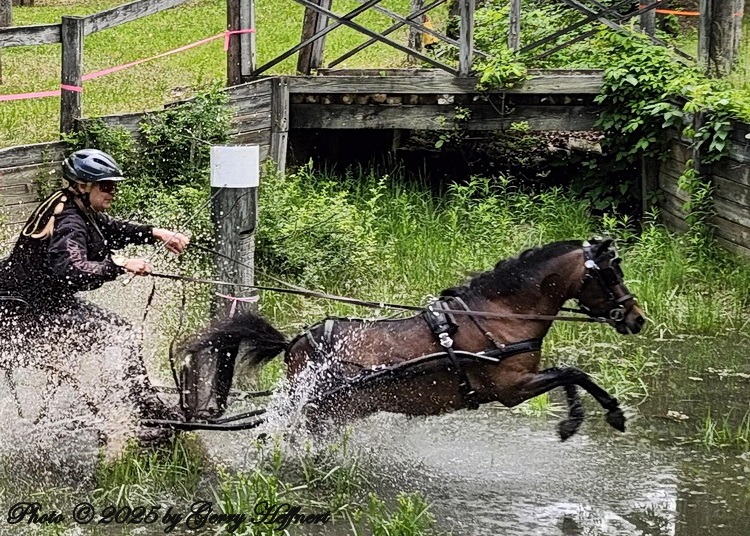
by Nancy Jaffer | May 18, 2025
The stories are amazing. Even those who weren’t in Gladstone, N.J., for the 1993 World Pair Driving Championship have heard what a spectacular competition it was, with a record 23 countries participating at Hamilton Farm, home of the U.S. Equestrian Team Foundation.
Although there had been other good combined driving events at Gladstone before and after the championship, nothing else held there ever could match the championship, where the marathon segment was watched by 15,000 spectators. That was a unique experience.
But as time went on, the importance of the driving event in the Pine Meadow section of the property diminished. That’s what happens when supporters move, retire or pass away.
The Gladstone Equestrian Association, founded by the late Finn Caspersen and now headed by James C. Brady III, has sought to rejuvenate competition at the site. Over the weekend, its horse driving trial and combined test (dressage and cones without the marathon) drew 40 entries, the maximum it could handle logistically.
“We’re super-excited because for the first time in probably 10 years, we were completely sold out,” said Christine Siracusa, a volunteer and sponsorship coordinator.
The ground was soaked by torrential rain during the week, so some drivers opted to scratch the marathon and compete in the combined test instead due to mud.
But others, from those driving mini horses (also known as VSEs — very small equines) to pairs of horses, opted to forge ahead in the best sporting tradition.
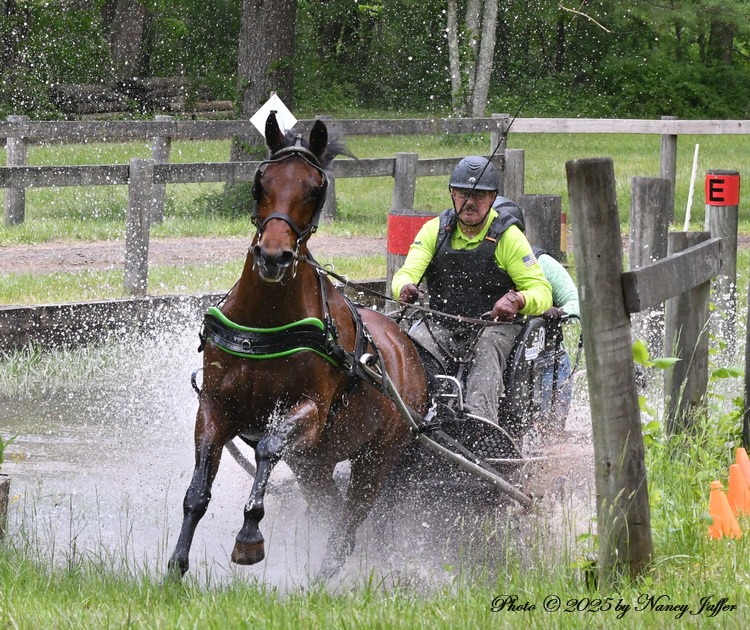
GEA Gladstone Driving President John Layton and Eris K (a Cleveland Bay otherwise known as The Beast) won the Single Horse Preliminary division. (Photo © 2025 by Nancy Jaffer)
A small but mighty volunteer base, several of whom had been lending a hand to Gladstone driving events even before the Pair Championship took place, did yeoman work to make the 2025 competition happen.
“Mother nature was not our friend this week. We ended up having three course changes, but our course designer (Bruce Jones) and officials were amazing,” said Christine Siracusa, a coordinator of volunteers and sponsorship.
“The weather couldn’t have been any better” on Saturday and Sunday.
Having some time to dry out, the marathon course “was not as mucky as we thought it would be,” she pointed out.
“I was at the finish line and saw everyone smiling. They were excited, they kept on thanking us for putting on a fabulous event and hopefully, they’ll keep coming back and supporting this event.”
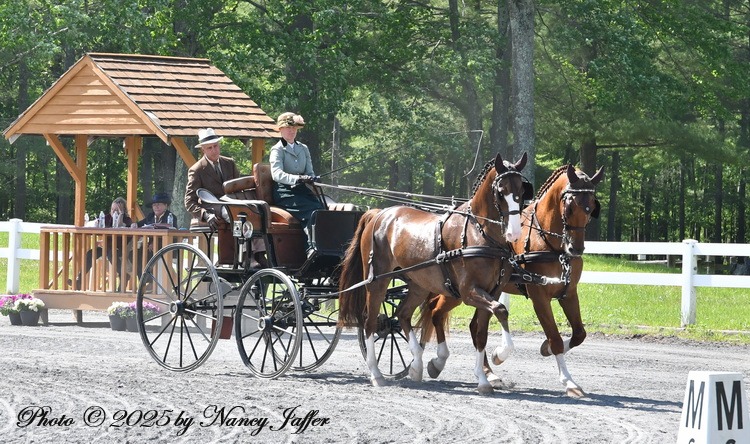
Alice Tarjan, better known for ridden dressage than driven dressage, skillfully guided Patser and Naferno in the Preliminary Pairs competition. (Photo © 20)25 by Nancy Jaffer)
John Layton, the GEA Gladstone Driving president, was thrilled by the number of entries and has big plans for next year. He hopes to reopen and re-do the former George’s Gorge marathon obstacle, fixing it up and renaming it the Gulch of the Northeast. John also wants to see a tailgating destination near there for optimum viewing of the action..
Amie Bauman, who handles the same duties as Christine for the GEA, is a driving professional from Pennsylvania who teaches and trains, as well as competing.
She guided Lois Kennedy’s 5-year-sold VSE stallion, Sundance, to victory in the VSE Single Preliminary, with 113.77 penalties, the best score in any of the Preliminary divisions.
“He’s a natural at it. He has so much talent. He just loves it,” she said of the bold little stallion, who handled the marathon obstacles with energy.
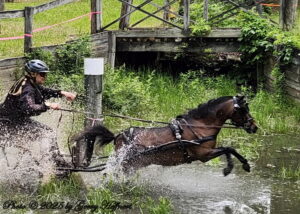
Amie Bauman and Sundance at the water obstacle. (Photo © 2025 by Gerry Heffner)
Amie has been coming to the driving event since 1983, the days of fellowship when local legends Bill Orth, George Hoffman, Joe Urso, Norm Sutton and George Millar — all gone now — were competing.
Looking to the future of the event, she said, “It absolutely has to keep going. It’s such a historic piece of property and we don’t really have many driving events in the North anymore.”
She works with the GEA and helps keep up the property for the event.
In that regard, she cited the assistance of Paul Miller Land Rover in fixing roads and cutting down some trees; the USET Foundation and its facility manager Maureen Pethick, who “have been incredible,” hiring a company to fix the roads and helping wherever needed, and the Hamilton Farm Golf Club, which also cut down trees and loaned equipment to the volunteers readying Pine Meadow for the competition.
Amie added, “I just need to give a shout out to the Gladstone Equestrian Association and all the people that are on it, and also all of the volunteers who help. Without them, none of this would happen.”
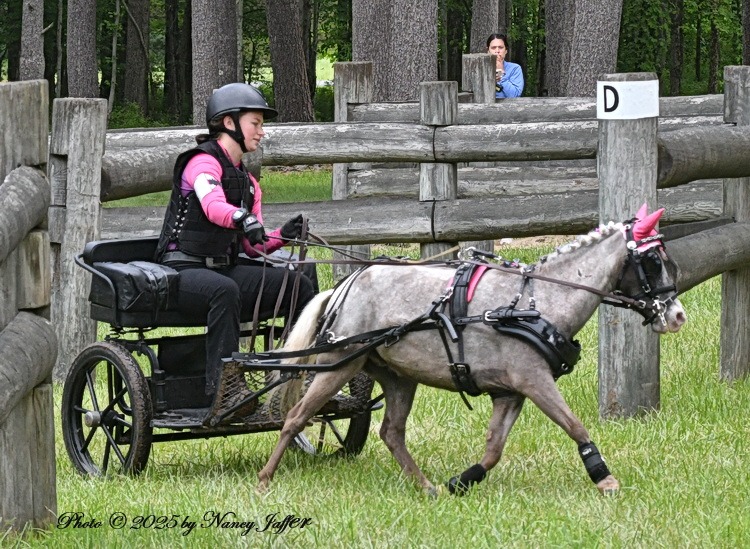
Kate Pantelione and Addalittlespice were pretty in pink.( Photo © 2025 by Nancy Jaffer)
Shelly Temple, president of the ground jury, believes it’s important for the GEA driving trials to continue.
“The history of this place is incredible. We’ve all competed here every year. The obstacles are still very workable. I think it’s a great show. You have a lot of dedicated people who want to keep it going, a good group to bring it forward and they’re getting sponsors, so I think there’s a lot of potential. There’s a lot possible here. There were new competitors, I didn’t know a lot of them; a lot of young people were here, which I love.”
But she added, “more people need to step up and help this crowd that has kept it going. It’s very important for our sport.”
Competitors’ horses were able to stay in the historic USET stable, elegant with its tile floors and polished brass.
“That’s a great benefit to showing here,” mentioned Shelly, a 2007 team bronze medalist in the World Pony Driving Championships.
Another judge, Lisa Singer, was equally as enthusiastic.
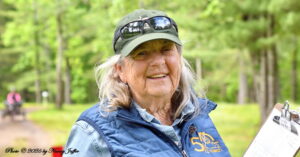
Lisa Singer on the job. (Photo © 2025 by Nancy Jaffer)
She was National Pairs Champion nine times and a member of the U.S. team at eight World Pair Championships. Lisa no longer drives competitively, but teaches, trains, runs shows, gives clinics and designs courses.
Looking at the roster of competitors on her clipboard, she said, “What was neat was that I only knew three people on this list. There’s a lot of new people, a lot of young people coming. That’s awesome.”
Click here for Horse Trial results. Click here for Combined Test results.




























